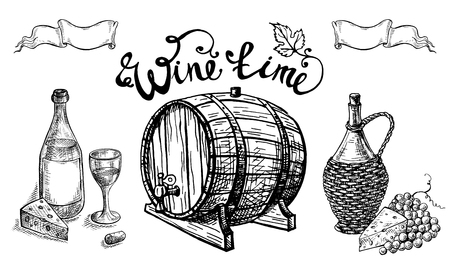Introduction: Climate Change and the Alcohol Industry
Climate change is emerging as one of the most significant challenges facing agriculture worldwide, and its impact is especially profound in industries that depend on precise environmental conditions, such as wine and whisky production. Traditionally, both wine and whisky have thrived in regions where temperature, rainfall, and soil composition create the perfect setting for high-quality grapes and barley. However, shifting climate patterns, rising global temperatures, unpredictable weather events, and prolonged droughts are starting to disrupt these delicate balances. As a result, investors who once considered wine and whisky as stable long-term assets are now forced to rethink their strategies in the face of growing environmental uncertainty. This article explores how climate change is transforming the landscape for wine and whisky investments in the United States and around the world.
2. How Weather Patterns are Disrupting Grape and Barley Production
Climate change is shaking up the traditional landscapes of wine and whisky production, with unpredictable weather patterns posing serious challenges for both grape growers and barley farmers. In regions like California’s Napa Valley or Scotland’s Speyside, shifting seasons are causing earlier harvests, lower yields, and inconsistent crop quality. The increased frequency of droughts, wildfires, and heatwaves has forced producers to rethink their strategies for cultivation and long-term investment.
Droughts and Water Scarcity
Grapes and barley are highly sensitive to water availability. Extended droughts in places such as California and Australia have led to irrigation restrictions, stunted vine growth, and reduced grain output. This not only affects current production but also threatens the sustainability of vineyards and distilleries relying on consistent yields year after year.
Wildfires: A Growing Threat
Wildfires have become more common in key wine regions, especially in the American West. Smoke taint—a phenomenon where grapes absorb smoke compounds—can ruin entire vintages and devastate small wineries. For whisky producers, wildfires threaten barley fields and disrupt supply chains, increasing production costs and insurance premiums.
Extreme Temperatures Impacting Quality
Sudden spikes or drops in temperature can disrupt the delicate ripening process for both grapes and barley. Grapes exposed to excessive heat may lose acidity and develop undesirable flavors, while barley affected by frost or heat stress may yield lower starch content, impacting fermentation efficiency for distilleries.
Regional Disruptions at a Glance
| Region | Main Crop | Primary Climate Challenge |
|---|---|---|
| Napa Valley (US) | Grapes | Droughts & Wildfires |
| Bordeaux (France) | Grapes | Heatwaves & Early Harvests |
| Speyside (Scotland) | Barley | Unpredictable Rainfall |
| Tasmania (Australia) | Barley & Grapes | Frost & Heat Stress |
The cumulative effect of these disruptions is changing the map for wine and whisky investments. As traditional growing areas face mounting risks, investors must pay closer attention to how these environmental shifts could impact future returns and the very character of premium beverages.

3. Changing Tastes: Impact on Flavor Profiles and Quality
One of the most noticeable effects of climate change on the wine and whisky industries is the alteration of flavor profiles, quality, and consistency—three factors that are deeply important to American consumers and investors alike. As temperatures rise and weather patterns become more unpredictable, the delicate balance required for growing grapes and cultivating barley is increasingly difficult to maintain. For wine, this often means faster ripening, which can lead to higher sugar levels but lower acidity, fundamentally changing the taste and mouthfeel of classic varietals like Napa Valley Cabernet Sauvignon or Oregon Pinot Noir. In some cases, wines may become “jammy,” losing their signature freshness and complexity, potentially disappointing enthusiasts who seek out specific regional characteristics.
Whisky faces its own set of challenges. The maturation process depends heavily on stable environmental conditions; hotter summers and milder winters can accelerate aging in the barrel, impacting both the depth and subtlety of flavors over time. American whiskey producers—especially those in Kentucky and Tennessee—are already noticing fluctuations in batch consistency as a result. These climate-driven shifts can result in bottles that vary significantly from year to year, introducing unpredictability for collectors and drinkers who expect reliability from legacy brands.
Ultimately, these changes force both industries to innovate or adapt, which might involve experimenting with new grape varieties or sourcing grains from different regions. While some adventurous consumers may welcome bolder or unexpected flavor experiences, others may find their favorite wines or whiskies no longer taste as they remember. This evolving landscape not only influences consumer preferences but also adds a layer of risk—and opportunity—for those considering wine or whisky as long-term investments.
4. Investment Uncertainty: Risks and Opportunities
As climate change continues to disrupt traditional wine and whisky-producing regions, investors face a new landscape marked by both elevated risks and fresh opportunities. The unpredictability of weather patterns, increased frequency of extreme events, and shifting terroirs are introducing greater volatility into the value of fine wines and rare whiskies. Scarcity caused by poor harvests or damage to distilleries can drive prices up sharply, but also brings uncertainty regarding future supply and demand. For investors, this means navigating an environment where past performance is no longer a reliable indicator of future returns.
Risks Facing Wine and Whisky Investors
| Risk Factor | Description | Potential Impact |
|---|---|---|
| Price Volatility | Unpredictable weather events may cause sharp fluctuations in production levels. | Sporadic surges or drops in market prices for certain vintages or bottles. |
| Scarcity | Extreme weather can reduce harvest yields or destroy stock. | Limited availability may increase values but also risk bubble-like behavior. |
| Changing Terroir | Traditional regions may lose their unique characteristics due to altered climates. | Diminished reputation and long-term brand value for legacy producers. |
| Regulatory Changes | New environmental policies could impact production practices or supply chains. | Compliance costs and shifting industry standards may affect profitability. |
Opportunities in New Regions and Resilient Brands
While established wine regions like Napa Valley or Bordeaux grapple with unpredictable growing conditions, new areas—such as parts of Oregon, Canada, or even England—are emerging as promising alternatives. Similarly, whisky producers in traditionally cooler climates may find competitive advantages as global temperatures rise. Forward-thinking brands investing in sustainable agriculture and climate adaptation strategies are likely to outperform those that stick to business as usual. Investors who diversify their portfolios to include these innovative players could benefit from the resilience and growth of these sectors.
Examples of Emerging Opportunities:
- Expansion into Cooler Climates: Regions previously unsuitable for premium wine or whisky production are now entering the spotlight, offering ground-floor investment chances.
- Sustainable Practices: Brands adopting water conservation, regenerative farming, or renewable energy are gaining consumer trust and long-term viability.
- Climate-Resilient Varietals: Producers experimenting with heat-tolerant grape varieties or grains are positioning themselves for continued success amid changing conditions.
Navigating the New Investment Landscape
The bottom line: Climate change is shaking up the traditional dynamics of wine and whisky investments. While increased risks demand careful due diligence, they also open doors to new markets and innovative brands. Staying informed about climate trends, regulatory changes, and technological advances will be essential for investors aiming to balance risk with reward in this evolving sector.
5. The Shift in Wine and Whisky Regions
Climate change is redrawing the map for wine and whisky investments. Traditionally, regions like California’s Napa Valley and Scotland’s Highlands have enjoyed almost legendary status among investors and collectors. However, rising temperatures, unpredictable weather patterns, and increased frequency of wildfires are putting these classic areas under unprecedented stress. These challenges threaten both the yield and quality of grapes in Napa and disrupt the delicate maturation process of whisky casks aging in Scotland’s cool, damp warehouses.
As a result, the focus of savvy investors is expanding beyond these well-known locales. In the U.S., previously overlooked states like Oregon, Washington, and even parts of New York are gaining recognition for their increasingly favorable grape-growing conditions. Similarly, American whiskey producers in Kentucky are exploring higher elevation storage and experimenting with new barrel techniques to counteract hotter summers and more volatile humidity levels.
Globally, climate shifts are also driving innovation. England is now producing sparkling wines that rival those from Champagne, thanks to warmer growing seasons. Canadian and Scandinavian distilleries are emerging as serious contenders in the whisky world, leveraging cooler climates that have become ideal as traditional regions heat up. Investors are beginning to see potential in these “new frontier” regions—places once considered too cold or inhospitable for premium production but now poised for growth as climate zones shift.
For those looking to future-proof their wine or whisky portfolios, diversifying holdings to include products from these emerging areas could pay off handsomely. Not only do they offer unique terroir-driven profiles sought after by connoisseurs, but they may also be better positioned to withstand ongoing environmental changes than their historic counterparts.
Sustainable Practices and the Future of Investing
As climate change disrupts traditional growing regions for wine and whisky, producers are increasingly embracing innovative and sustainable agricultural practices. These changes are not just about environmental stewardship—they’re fundamentally reshaping the landscape for investors seeking long-term value in these industries.
Embracing Innovation in the Vineyard and Distillery
Forward-thinking vineyards and distilleries across the United States are leading the charge by adopting eco-friendly techniques such as regenerative farming, precision irrigation, and organic certification. Many have begun experimenting with drought-resistant grape varietals or heritage grains that require fewer resources. Such measures can improve soil health, reduce water consumption, and enhance resilience to unpredictable weather, all while maintaining or even elevating product quality.
Transparency and Traceability as Investment Drivers
American consumers—especially Millennials and Gen Z—are demanding greater transparency about how their beverages are produced. Producers who prioritize sustainability can now leverage blockchain technology for traceability, ensuring every bottle’s journey from field to shelf is documented. For investors, this level of accountability translates into stronger brand reputation and customer loyalty, which can boost a product’s desirability and long-term market value.
Aligning Portfolios with Green Values
The shift toward sustainable production isn’t just good for the planet; it also aligns with evolving investor priorities. Environmental, Social, and Governance (ESG) criteria are becoming central to many American investment strategies. Wine and whisky brands that demonstrate measurable commitments to sustainability may attract greater capital flows from ESG-focused funds, driving up asset values over time.
Ultimately, investing in producers who are adapting sustainably positions portfolios for future growth. As climate risks intensify, companies that innovate today are likely to become tomorrow’s industry leaders—delivering both competitive returns and positive environmental impact.
7. Conclusion: Navigating the Evolving Landscape
The world of wine and whisky investing is being reshaped by the undeniable impacts of climate change, but opportunity still exists for those who are ready to adapt. Investors must stay informed about how shifting weather patterns, changing regulations, and evolving consumer preferences are impacting vineyards and distilleries around the globe. By keeping up with climate science, monitoring developments in sustainable production practices, and tracking which regions are becoming more or less viable for premium wine and whisky, you can make smarter decisions about your portfolio.
Adaptability is key—what worked in the past may not guarantee success in the future. Consider diversifying your holdings across different regions, grape varietals, or spirit styles that show resilience to climate volatility. Don’t shy away from emerging producers or new terroirs that may benefit from changing conditions. At the same time, remain proactive by regularly reassessing your investments and seeking out expert advice on both environmental trends and market dynamics.
Ultimately, protecting and growing your wine and whisky portfolio in this era means embracing innovation while respecting tradition. Those who are prepared to evolve along with the industry can find fresh opportunities—even as old certainties fade away. Stay vigilant, keep learning, and let adaptability guide your investment journey through this ever-changing landscape.

